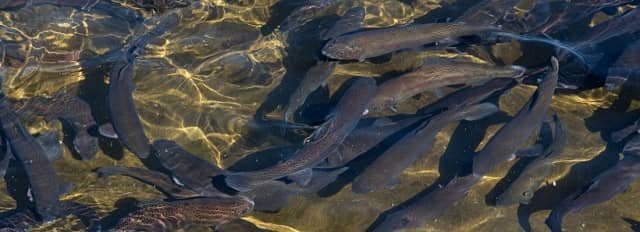by INRAE
The world’s oceans can no longer sustain the ever-rising demand for fish. Aquaculture offers an alternative approach – if production is sustainable and high quality. INRAE, the Aqualande group and its selective breeding company Les Sources de l’Avance, and the French Poultry and Aquaculture Breeders Technical Center (SYSAAF) reviewed data from 20 years of a rainbow trout breeding programme conducted by the company. They compared the growth and nutrition needs of trout from this programme with those of an unselected trout population. Their findings, published in Aquaculture Reports, show that selected trout need 17% to 20% less feed to achieve the same growth as the unselected ones.

As a result, the environmental impacts of fish farming can be reduced. A locally produced feed, made without fish oil, fishmeal or soy, was also tested on both groups of fish. The fish fed this “future” feed, which has similar nutritional characteristics, achieved similar growth performance. These unique results show that selective breeding and innovative feed sources can be effectively combined to make aquaculture more sustainable.
Between 1997 and 2019, the Aqualande group conducted a selective breeding programme on 10 generations of rainbow trout, based on the principles established by INRAE and the SYSAAF. They also maintained unselected rainbow trout from the same original population. To determine the genetic gains in performance, INRAE, Aqualande and the SYSAAF participated in the collaborative European research programme AquaImpact, during which they compared the growth, morphology, yield and fillet lipid content of the selected and unselected groups of fish. They also developed a sustainable feed based on INRAE research that was made without fish oil, fishmeal or soy to limit non-European imports. This feed was produced with ingredients from France and Europe, such as potato protein and microalgae. For 110 days, trout from both groups were given this feed, while others were fed a standard commercial feed containing fishmeal and fish oil.
The results show that trout from the selective breeding programme needed 17% to 20% less feed than the unselected trout to achieve the same growth. Moreover, their fillets had a higher lipid content, which improves their nutritional and taste profiles. Whether fed with the sustainable or the standard feed, trout from both groups grew at the same rates. Adding microalgae to the sustainable feed also enhanced the nutritional quality of the fillets, which contained just as many Omega-3 long-chain fatty acids as fillets from trout given the standard feed containing fish oil.
This study shows that selective breeding and the development of sustainable feeds are two important levers for reducing the environmental impact of farmed fish production and accelerating the transition to a more sustainable aquaculture.
Contact
Marc Vandeputte
MARBEC, Univ Montpellier, CNRS, Ifremer, IRD, INRAE, Palavas-Les-Flots, France
Francemarc.vandeputte@inrae.fr
Reference (open access)
Marc Vandeputte, Geneviève Corraze, Jérôme Doerflinger, Florian Enez, Frédéric Clota, Frédéric Terrier, Mathilde Horat, Laurence Larroquet, Vincent Petit, Pierrick Haffray, Sandrine Skiba-Cassy, Mathilde Dupont-Nivet. Realised genetic gains on growth, survival, feed conversion ratio and quality traits after ten generations of multi-trait selection in rainbow trout Oncorhynchus mykiss, fed a standard diet or a “future” fish-free and soy-free diet. Aquaculture Reports Volume 27, December 2022, 101363, DOI : https://doi.org/10.1016/j.aqrep.2022.101363
Editor at the digital magazine AquaHoy. He holds a degree in Aquaculture Biology from the National University of Santa (UNS) and a Master’s degree in Science and Innovation Management from the Polytechnic University of Valencia, with postgraduate diplomas in Business Innovation and Innovation Management. He possesses extensive experience in the aquaculture and fisheries sector, having led the Fisheries Innovation Unit of the National Program for Innovation in Fisheries and Aquaculture (PNIPA). He has served as a senior consultant in technology watch, an innovation project formulator and advisor, and a lecturer at UNS. He is a member of the Peruvian College of Biologists and was recognized by the World Aquaculture Society (WAS) in 2016 for his contribution to aquaculture.
Stay Always Informed
Join our communities to instantly receive the most important news, reports, and analysis from the aquaculture industry.




